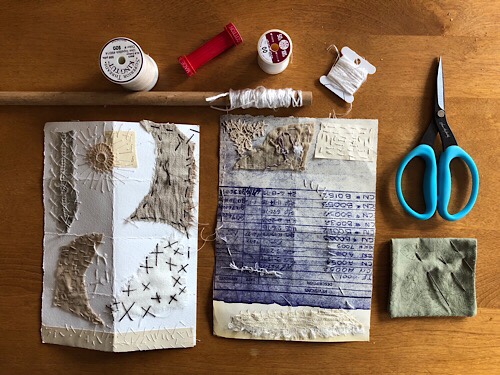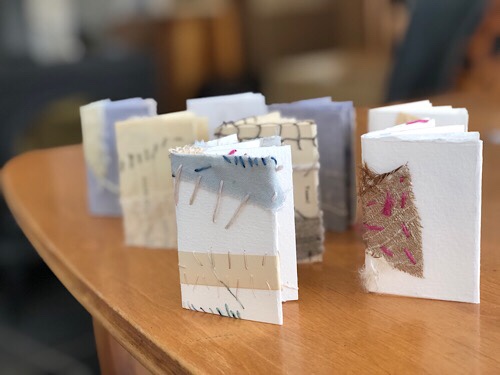Four Winds Books in progress

I’ve stitched and folded 15 little books for India Flint’s School of Nomad Arts class being (t)here 2019.
- Paper Connection‘s vintage handmade 100% cotton paper, made in England. Gelatin-sized. 90 lb. I bought a packet of this at the Book Arts Bazaar in Portland on April 7 and was eager to try it in a project. It set the size for the project, being precut to A5.
- Fluid 100 watercolor paper. 140 lb, 100% cotton, cold press. I used the last sheet in the pad, which is always kind of a thrill. This is the thickest paper I used, and it gave some trouble in folding, but was not insurmountable.
- Ingres pastel paper, 100% cotton. 45 lb., white, rough. My favorite for stitching into.
- Blueprint paper from my dad’s files, showing work on the mirror assembly for the Hubble Space Telescope. It did not feel like a natural juxtaposition to stitch into engineering documents, but I liked the purple tone and the variety of lettering, including my dad’s initials signing off on revisions.
- Pages torn from a book picked up at the Hancock Library book sale last summer “Coloured Pictures of Representative Flower Arrangements by SÅŒFŪ.” I used pages from the Table of Contents which had subtly shiny inclusions that might be silk? And a couple of the pages describing the arrangements.

The stitching process proceeded quickly and easily. It was helpful to make myself a little bag including a selection of fabrics and threads to use.
I cut into a lace collar that I’ve been saving forever. It was a gift from my ex-mother-in-law, Natalie. I will never wear it as a collar so it’s finally finding a home in pieces.
I found it delightful to stitch bits of thread fuzz into a couched net that affixed them to the surface. Bright pink tones came from thread dyed with cochineal. I also used thread dyed a deep dark purple from India’s a clearing in the woods project – a nice continuity.

I had to cut each sheet through the center to enable the folding. I tried to avoid stitching in this area. Sometimes I had to mend some stray bits after cutting.


Now it’s on to the next step, which is dyeing. First I have to get the rusted lid off my jar of magic potion (solution of vinegar and rusty objects). Then I have to forage some objects to bind the books against before dyeing. I have most of the plant materials ready, might collect a few more.
Meanwhile, enjoying the chunky little stack of books, which are quite beautiful at this stage. Beautiful at every stage, as India says.

